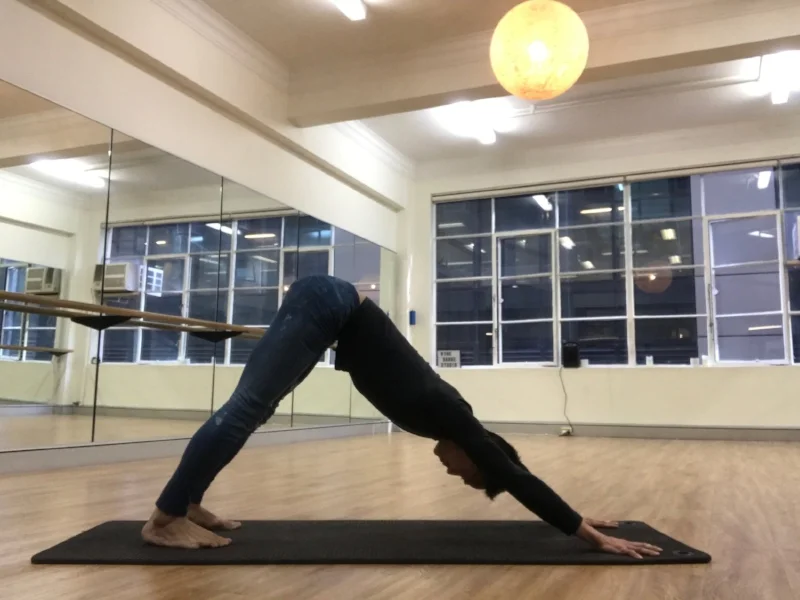Nail these three basic yoga poses to relieve desk fatigue
/When the office chair is leaving you hunched, and stress is giving you grief, there's nothing like a good stretch to get you feeling right again. But if you can't get into the studio right away, why not try some simple stretches at home or at the park?
1. Cobra
Cobra is a great pose for opening the chest and strengthening your core. Opening the chest is great for those of us who spend too much time hunched over a computer!
To achieve cobra, lay face down with your palms pressed evenly into the ground next to your shoulders. Squeeze the buttocks lightly, press your pelvic bone into the floor, and inhale and lift the torso away from the ground, being careful not to feel pain in your lower back. Keep your elbows close to your side, drop your shoulders down and back, and press your chest forward and through. Make sure to keep your elbows bent if having straight arms isn't possible or comfortable. Hold for as long as your breathing remains comfortable and your body is not telling you to stop - anywhere from 2 to 6 breaths. To release this pose, lower yourself in a controlled manner back down to the floor.
If this pose is too strong for you, try sphinx for a similar feeling that puts less strain on the back.
2. Downward Dog
While in your early stages of practice Downward Dog can seem a challenge, this pose is actually a great way to check in with your body! For such a simple pose, it can see really challenging when you can't get your heels to the floor, or feel like your shoulders and arms can't support you. Persist!
One of the best benefits of Downward Facing Dog is that it stretches the whole body. You will feel the stretch all down the back of your body - through your feet, calves, hamstrings, back and shoulders. As a mild inversion (your heart is higher than your head) you also get the benefit of having the blood flow increased to your head, helping to relieve headaches and fatigue. Any inversion pose boots your circulation, which helps with immune function and flushing toxins. It also helps to build upper body strength, and relieve back pain and stiffness.
To move into downward dog, start on all fours, planting your whole hand into the ground directly below your shoulders, and knees directly under your hips, turning your toes under so they are planted into the floor. Your hips and shoulders are different widths, so keep this in mind when aligning them.
Lift your knees off the floor, sending your hips up towards the roof and drawing your sit bones back towards the wall behind you. Do not straighten your legs immediately, keep a bend to allow your body time to adjust to the pose. Make sure your whole hand is planted into the floor; you do not want to jam weight into your wrists and palms. Your should feel like even the pads of your fingers are connecting with the floor to support you. Draw your shoulder blades back towards your spine so as to not strain them either, and let your neck relax without dangling, gazing back towards your legs. You want your back to remain straight, and to draw your ribs in as well rather than letting them sink to the floor.
Keep drawing your chest back towards your thighs. Do not stress if your heels do not touch the floor when your legs are straight. To help relax your heels closer to the floor, you can do what is called "Walking your dog". Bend one leg to allow the other leg and heel to sit closer to the floor while straight and 'cycle' through this motion four or five times, keeping your upper body in position and strong. Then allow yourself to settle into a straight legged downward dog. Hold for as long as is manageable - your breathing should remain comfortable.
To release this pose, drop your knees back to the floor, and rest back into child's pose.
3. Warrior 2
The warrior sequence is a popular collection of yoga asanas frequently used in vinyasa or flow classes. These poses are well known for their mix of strength and strength, targeting hip flexibility and toning the legs. Warrior 2 is excellent for building strength and stability, as well as flexibility for your body and hips. It also encourages your chest and shoulder blades to open outwards, helping to relieve tension from sitting over a desk.
To enter this pose, start by standing with your feet together, planted into the floor and with your palms pressed together at your heart centre. Step one foot back behind you as far is comfortable to go. Turn the back foot at a 90 degree angle and plant the foot into the floor. Your heels should be in alignment and your thighs firm. Rotate your torso in the same direction as the foot you sent backwards, and reach your arms out wide, in front and behind you to open your shoulders and chest out. Make sure they are parallel to the floor.
Check your body at this point. Make sure your front knee is directly over the ankle. Make sure the weight in the front foot is spread evenly through the inside and outside of the foot, and the ball and heel. Make sure your front knee leg is not rotating inwards but stays equally over the foot.
Hold this pose for as many breaths as remains comfortable. Inhale to step the back leg forward to come out of this pose.
Give these poses a go and let us know how you go! Our yoga instructors (the gorgeous Thana, Kimberly and Chelsea) are always happy to give you tips to better execute your yoga practices and alignments!





